
Wild weather – and the entrance of some wild directors into our survey. This week’s forecasts are predominated by the beginnings of the true Looney Tunes spirit, with three entries from Warner’s first true superstar, Porky Pig. One is a memorable early effort by the king of gags, Fred “Tex” Avery, who also contributes a Merrie Melodie for good measure to our offerings. Another classic comes from the rival pencil of equally-unrestrained madman Bob Clempett. The competition tries to keep up, with contributions from Fleischer, Lantz, and Terrytoons, but admittedly takes a back seat – signaling the beginnings of Warner’s rise to prominence as one of the three major players to shape the future of the animated short in America.
 The Hot Spell (Terrytoons/Educational, Farmer Al Falfa, 7/10/36 – Mannie Davis, dir.) – Farmer Al’s farm is again facing a severe heat wave and drought. Even the sun is perspiring profusely, with drops of sweat trickling down its nose. Puddy the Pup trues to help Al out in his planting of seed, by carrying a shade umbrella tied to his tail. But it doesn’t last long, as the sun emits an exhausted exhale – full of fire – that burns the umbrella to a crisp. Al’s existing crops are wilting, and his well literally melts into the ground, disappears, and seals the hole in the earth over itself. Al tries to apply the contents of a watering can to the soil where he has just done his planting – but the water instantly disappears upon touching the ground, evaporating in a trail of steam. Suddenly, Al and Puddy simultaneously see an amazingly inviting sight. A small lake seems to have appeared, right in the middle of the farmer’s field, complete with ducks swimming around within it. “Water”, cries out Al, and both he and Puddy make a dive for the vision – which turns out to be only that – a mirage, leaving Al doing the breast stroke on his belly upon parched land.
The Hot Spell (Terrytoons/Educational, Farmer Al Falfa, 7/10/36 – Mannie Davis, dir.) – Farmer Al’s farm is again facing a severe heat wave and drought. Even the sun is perspiring profusely, with drops of sweat trickling down its nose. Puddy the Pup trues to help Al out in his planting of seed, by carrying a shade umbrella tied to his tail. But it doesn’t last long, as the sun emits an exhausted exhale – full of fire – that burns the umbrella to a crisp. Al’s existing crops are wilting, and his well literally melts into the ground, disappears, and seals the hole in the earth over itself. Al tries to apply the contents of a watering can to the soil where he has just done his planting – but the water instantly disappears upon touching the ground, evaporating in a trail of steam. Suddenly, Al and Puddy simultaneously see an amazingly inviting sight. A small lake seems to have appeared, right in the middle of the farmer’s field, complete with ducks swimming around within it. “Water”, cries out Al, and both he and Puddy make a dive for the vision – which turns out to be only that – a mirage, leaving Al doing the breast stroke on his belly upon parched land.
 Enter Al’s old nemesis, the City Slicker. In a fast-talking sales pitch, he sells Al a box marked “Dynamo Rain Maker”, which for $5.00, the salesman guarantees will cause rain to come down in torrents for five years. Al coughs up the required dough, and unpacks the box, which includes blasting powder and a dynamite plunger. Planting the powder in the ground, Al presses the plunger, and waits for the results. It rains, all right – but rains rocks blown out of the ground from the explosion. Al gets a good conk on the head from a boulder, and lies unconscious on the ground. But suddenly, things start to change (cue the dream sequence). Gentle rain begins to fall everywhere. Corn stalks rise and begin to sprout giant ears. The well resurfaces from the ground, and overflows past its brim. Flowers spring up everywhere, including lilies whose bells blow like trumpets. However, a beanstalk of proportions worthy of Jack springs up under Al, carrying him into the clouds. He finds a castle above, but it is not inhabited by a giant, but by Joe Pluvius, a whiskered rainmaker of the heavens. Upon Al’s intrusion, turrets of the castle transform into hoses and water nozzles, and begin spraying Al in the face. Joe emerges from the castle on a water wagon, also equipped with hose, and insists that no one can make it rain except Joe Pluvius. He blasts Al backwards with the water spray, off the clouds and back down to Earth. There, Al still believes he is feeling rain on his face – but it is only the affectionate tongue of Puddy, reviving the old farmer from his dream. Everything is as dry as ever, and Al is left massaging the lump on his head for the iris out.
Enter Al’s old nemesis, the City Slicker. In a fast-talking sales pitch, he sells Al a box marked “Dynamo Rain Maker”, which for $5.00, the salesman guarantees will cause rain to come down in torrents for five years. Al coughs up the required dough, and unpacks the box, which includes blasting powder and a dynamite plunger. Planting the powder in the ground, Al presses the plunger, and waits for the results. It rains, all right – but rains rocks blown out of the ground from the explosion. Al gets a good conk on the head from a boulder, and lies unconscious on the ground. But suddenly, things start to change (cue the dream sequence). Gentle rain begins to fall everywhere. Corn stalks rise and begin to sprout giant ears. The well resurfaces from the ground, and overflows past its brim. Flowers spring up everywhere, including lilies whose bells blow like trumpets. However, a beanstalk of proportions worthy of Jack springs up under Al, carrying him into the clouds. He finds a castle above, but it is not inhabited by a giant, but by Joe Pluvius, a whiskered rainmaker of the heavens. Upon Al’s intrusion, turrets of the castle transform into hoses and water nozzles, and begin spraying Al in the face. Joe emerges from the castle on a water wagon, also equipped with hose, and insists that no one can make it rain except Joe Pluvius. He blasts Al backwards with the water spray, off the clouds and back down to Earth. There, Al still believes he is feeling rain on his face – but it is only the affectionate tongue of Puddy, reviving the old farmer from his dream. Everything is as dry as ever, and Al is left massaging the lump on his head for the iris out.
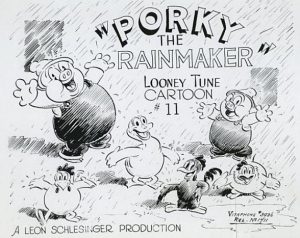 Porky the Rainmaker (Warner, Looney Tunes (Porky Pig), 8/1/36 – Fred (Tex) Avery, dir.) – Droughts in the farmlands must have been current news this season, as it is interesting that Avery’s unit could not possibly have had enough lead time to have seen Farmer Al’s plight and borrowed ideas from it – and yet, less than a month later, here comes a Porky title on a significantly similar theme. Porky’s poppa’s farm is drying up. Apples and foliage wither from a tree before our eyes, as a narrator and chorus quote wearily from the popular song – “Looks like there’ll be no shade – under the Old Apple Tree.” Water inside watermelons reaches the boiling point. Eggplants crack apart to drip our frying eggs. Even the farm animals are on strike, with picket signs from the chickens reading “No feed, no eggs”, and the cow wears a barrel around its udder, with “Closed Shop” written on the barrel’s side. Poppa pig gives Porky his last dollar to go into town for feed. Porky runs into town, but is sidetracked by the sounds of a sales pitch being delivered from the proprietor of a medicine show wagon. For the paltry price of $1.00, the salesman offers the solution to the farmers’ problem – a box of pills, not only including one rain pill, bit an assortment of pills to produce virtually any form of weather at all. The salesman demonstrates, by placing a rain pill into a tube, then blowing it skyward into the clouds. It explodes – and suddenly, there is a refreshing downpour. It seems the product is legit, and Porky trades his precious dollar for a box of pills instead of feed. Sounds a bit like Jack and the Beanstalk, doesn’t it? Well, though there’s no giant, beanstalk, or harp, Porky receives the same reception from Poppa as Jack did from his mom – disbelief and astonishment that Porky would be foolish enough to purchase pills, and a toss of the box of pills away into the farmyard.
Porky the Rainmaker (Warner, Looney Tunes (Porky Pig), 8/1/36 – Fred (Tex) Avery, dir.) – Droughts in the farmlands must have been current news this season, as it is interesting that Avery’s unit could not possibly have had enough lead time to have seen Farmer Al’s plight and borrowed ideas from it – and yet, less than a month later, here comes a Porky title on a significantly similar theme. Porky’s poppa’s farm is drying up. Apples and foliage wither from a tree before our eyes, as a narrator and chorus quote wearily from the popular song – “Looks like there’ll be no shade – under the Old Apple Tree.” Water inside watermelons reaches the boiling point. Eggplants crack apart to drip our frying eggs. Even the farm animals are on strike, with picket signs from the chickens reading “No feed, no eggs”, and the cow wears a barrel around its udder, with “Closed Shop” written on the barrel’s side. Poppa pig gives Porky his last dollar to go into town for feed. Porky runs into town, but is sidetracked by the sounds of a sales pitch being delivered from the proprietor of a medicine show wagon. For the paltry price of $1.00, the salesman offers the solution to the farmers’ problem – a box of pills, not only including one rain pill, bit an assortment of pills to produce virtually any form of weather at all. The salesman demonstrates, by placing a rain pill into a tube, then blowing it skyward into the clouds. It explodes – and suddenly, there is a refreshing downpour. It seems the product is legit, and Porky trades his precious dollar for a box of pills instead of feed. Sounds a bit like Jack and the Beanstalk, doesn’t it? Well, though there’s no giant, beanstalk, or harp, Porky receives the same reception from Poppa as Jack did from his mom – disbelief and astonishment that Porky would be foolish enough to purchase pills, and a toss of the box of pills away into the farmyard.
 The farm animals, famished from lack of feed, see the pills spill out, and assume they are edibles. A chicken swallows the lightning pill, and becomes a walking electrical bolt. The horse swallows the fog pill, and soon his horseflies are flying about radioing weather conditions of no visibility and ceiling zero. A goose gets a combined dose of the thunder and wind pills, producing an internal storm that rocks him with thundering sound effects, then blows him up for a gusty exhale, shooting him backwards from its recoil. Porky finally gets his pop to hear that one of the pills causes rain. Pop joins in the search on hands and knees for the missing pill. A few false alarms occur, as pills are discovered for cyclone and earthquake – only to be devoured by more of the chickens before they can be reached. One chicken begins to spin like a top, losing all of her feathers save one, which then spins off her like a little whirlwind under its own power. In underplay, she responds to the audience, “Well, imagine that.” The consumer of the earthquake pill goes into tremors which would no doubt be remembered by Chuck Jones years later for his similar gags for Wile E. Coyote in “Hopalong Casualty”. To try to stop the tremors, the chicken grabs hold of the nearest tree – and ends up shaking the entire earth in the process. Finally, Porky spots the rain pill – the only one not yet devoured. But the out of control goose blows into the shot, knocking Porky over. The goose also spots the pill, and downs it ahead of Porky’s reach. “Drop that p-pill”, stammers Porky, tugging at the goose’s long neck. But a rumble within the goose causes Porky to step back. The thunder and wind are at it again, and the force of the goose’s exhale acts exactly like the pill salesman’s launch of the pill into the clouds – producing the desired explosion and instant rain as promised. Crops spring back to life, and the happy hens lay enough eggs to build a small hill under the chicken coop. The cast celebrates amidst the downpour, then everyone breathes a sigh of relief, and strike a happy pose for the iris out – except the scene is spoiled, as all the other pills kick into effect again, leaving the cast in utter chaos, and launching the goose through the iris as it closes. He pounds on the blackened screen to be let back inside, and is seized by Porky’s arm from the reopening iris, to be dragged back in by the neck as the cartoon finally closes.
The farm animals, famished from lack of feed, see the pills spill out, and assume they are edibles. A chicken swallows the lightning pill, and becomes a walking electrical bolt. The horse swallows the fog pill, and soon his horseflies are flying about radioing weather conditions of no visibility and ceiling zero. A goose gets a combined dose of the thunder and wind pills, producing an internal storm that rocks him with thundering sound effects, then blows him up for a gusty exhale, shooting him backwards from its recoil. Porky finally gets his pop to hear that one of the pills causes rain. Pop joins in the search on hands and knees for the missing pill. A few false alarms occur, as pills are discovered for cyclone and earthquake – only to be devoured by more of the chickens before they can be reached. One chicken begins to spin like a top, losing all of her feathers save one, which then spins off her like a little whirlwind under its own power. In underplay, she responds to the audience, “Well, imagine that.” The consumer of the earthquake pill goes into tremors which would no doubt be remembered by Chuck Jones years later for his similar gags for Wile E. Coyote in “Hopalong Casualty”. To try to stop the tremors, the chicken grabs hold of the nearest tree – and ends up shaking the entire earth in the process. Finally, Porky spots the rain pill – the only one not yet devoured. But the out of control goose blows into the shot, knocking Porky over. The goose also spots the pill, and downs it ahead of Porky’s reach. “Drop that p-pill”, stammers Porky, tugging at the goose’s long neck. But a rumble within the goose causes Porky to step back. The thunder and wind are at it again, and the force of the goose’s exhale acts exactly like the pill salesman’s launch of the pill into the clouds – producing the desired explosion and instant rain as promised. Crops spring back to life, and the happy hens lay enough eggs to build a small hill under the chicken coop. The cast celebrates amidst the downpour, then everyone breathes a sigh of relief, and strike a happy pose for the iris out – except the scene is spoiled, as all the other pills kick into effect again, leaving the cast in utter chaos, and launching the goose through the iris as it closes. He pounds on the blackened screen to be let back inside, and is seized by Porky’s arm from the reopening iris, to be dragged back in by the neck as the cartoon finally closes.
 Hawaiian Birds (Fleischer/Paramount, Color Classics, 8/28/36 – Dave Fleischer, dir., Myron Waldman/Sam Stimson, anim.) – A sort of melodrama, set in two opposing climes – the tropical splendor of Hawaii, and the harsh weather of a Northern Big City (presumably the Fleischers’ home berth of New York). A young male bird of the tropics is busy building a love nest for his mate in a tree on the island, when the girl’s attention is attracted by a migrating flock of show birds passing through (the “Big City Orioles”). They pause in another tree for a top hat and tails rehearsal. The girl begins to shimmy and shake with the music, and wanders over to them. They encourage her dancing with a clapping rhythm, then applaud as her impromptu performance concludes. “How’d you like to join my troupe?”, says their leader. The girl shyly nods consent, and leaves her mate only a brief, non-apologetic note pecked out upon a leaf – “Gone North. Goodbye.” The boy, rather than merely dismissing her as a typical fickle female (has she been learning from Olive Oyl?), flies out over the ocean in the designated compass heading, determined to find her and win her back.
Hawaiian Birds (Fleischer/Paramount, Color Classics, 8/28/36 – Dave Fleischer, dir., Myron Waldman/Sam Stimson, anim.) – A sort of melodrama, set in two opposing climes – the tropical splendor of Hawaii, and the harsh weather of a Northern Big City (presumably the Fleischers’ home berth of New York). A young male bird of the tropics is busy building a love nest for his mate in a tree on the island, when the girl’s attention is attracted by a migrating flock of show birds passing through (the “Big City Orioles”). They pause in another tree for a top hat and tails rehearsal. The girl begins to shimmy and shake with the music, and wanders over to them. They encourage her dancing with a clapping rhythm, then applaud as her impromptu performance concludes. “How’d you like to join my troupe?”, says their leader. The girl shyly nods consent, and leaves her mate only a brief, non-apologetic note pecked out upon a leaf – “Gone North. Goodbye.” The boy, rather than merely dismissing her as a typical fickle female (has she been learning from Olive Oyl?), flies out over the ocean in the designated compass heading, determined to find her and win her back.
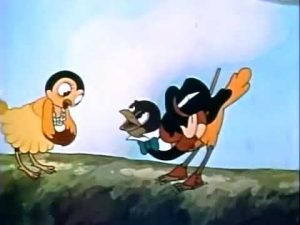 Against detailed three-dimensional sets on Fleischer’s turntable camera, the boy arrives at and searches the big city – which is coated with a thick blanket of snow. Perching on a frozen wire, the boy finds his feet sticking to the surface in frost, and has to clear ice from his toes, and brace himself in short, icy breaths against the effects of the cold. He thinks he has spotted his love buried under a coating of snow – but when he brushes the white stuff away, finds onlt a bird-shaped metal hood ornament on the radiator of a passing sedan. Meanwhile, within a gaslight atop a tall skyscraper, an evening’s performance is in progress, the light serving as the Orioles’ exclusive night club. Something has not gone well, and for reasons unexplained, the girl has not been a hit with the crowd. The troupe leader first pushes the girl out the door, then boots her out when she tries to re-enter the club, with an order to “Scram.” The girl is left seated in a snowdrift, as a new blanket of snow begins to fall around her. Winds blow through her native grass skirt, and she shudders in the cold, having no idea what to do. She ventures close to the edge of the roof, and gets a look at the view below – a street full of traffic, about forty stories down. She backs away from the ledge – but then pauses, tears streaming down her cheeks, and begins to nod as if she has made a decision. With a last fond look and kiss of a photo of her lost love she has carried inside her skirt, she decides to end it all. Being a bird, a fall isn’t likely to achieve such a result without some help – so, she extracts a long strand of grass from her skirt, wraps it around herself, and ties a knot to restrain her wings from extending. Then, after several hesitations, she begins to walk toward the edge. The boy, meanwhile, is still struggling along in the icy winds against the blowing snow, and stops to warm himself on the last remains of a burnt-out cigar butt someone has left on the sidewalk – finding himself standing just below the skyscraper where the girl approaches her drop of destiny. She takes the plunge, falling headlong over the edge – but collides headfirst with the head of her lover below. The impact is slight, merely bouncing her into soft snow – and she opens her eyes to find a reunion with her love. All ends happily, with the two returning to Hawaii to occupy the love nest, and the boy pulling the shade on the audience as their silhouettes embrace within the home, for the iris out.
Against detailed three-dimensional sets on Fleischer’s turntable camera, the boy arrives at and searches the big city – which is coated with a thick blanket of snow. Perching on a frozen wire, the boy finds his feet sticking to the surface in frost, and has to clear ice from his toes, and brace himself in short, icy breaths against the effects of the cold. He thinks he has spotted his love buried under a coating of snow – but when he brushes the white stuff away, finds onlt a bird-shaped metal hood ornament on the radiator of a passing sedan. Meanwhile, within a gaslight atop a tall skyscraper, an evening’s performance is in progress, the light serving as the Orioles’ exclusive night club. Something has not gone well, and for reasons unexplained, the girl has not been a hit with the crowd. The troupe leader first pushes the girl out the door, then boots her out when she tries to re-enter the club, with an order to “Scram.” The girl is left seated in a snowdrift, as a new blanket of snow begins to fall around her. Winds blow through her native grass skirt, and she shudders in the cold, having no idea what to do. She ventures close to the edge of the roof, and gets a look at the view below – a street full of traffic, about forty stories down. She backs away from the ledge – but then pauses, tears streaming down her cheeks, and begins to nod as if she has made a decision. With a last fond look and kiss of a photo of her lost love she has carried inside her skirt, she decides to end it all. Being a bird, a fall isn’t likely to achieve such a result without some help – so, she extracts a long strand of grass from her skirt, wraps it around herself, and ties a knot to restrain her wings from extending. Then, after several hesitations, she begins to walk toward the edge. The boy, meanwhile, is still struggling along in the icy winds against the blowing snow, and stops to warm himself on the last remains of a burnt-out cigar butt someone has left on the sidewalk – finding himself standing just below the skyscraper where the girl approaches her drop of destiny. She takes the plunge, falling headlong over the edge – but collides headfirst with the head of her lover below. The impact is slight, merely bouncing her into soft snow – and she opens her eyes to find a reunion with her love. All ends happily, with the two returning to Hawaii to occupy the love nest, and the boy pulling the shade on the audience as their silhouettes embrace within the home, for the iris out.
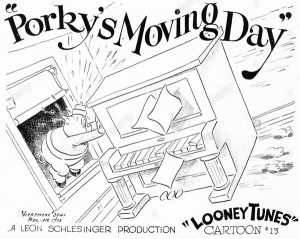 Porky’s Moving Day (Warner, Looney Tunes (Porky Pig) , 10/7/36 – Jack King, dir.) – An odd little cartoon, featuring an unusual aspect of unsettled weather – a flux of high tides, presumably resulting from a storm at sea, threatening to wash out a beachfront domicile. Miss Cud (in what may be her only Looney Tunes appearance following her teacher role in “I Haven’t Got a Hat”) frantically calls up Porky’s Moving Company to rescue her furniture and belongings before the rising waters get them. Porky’s crew consists of a simian referred to as “Dopey” who provides the brawn, and is obviously an ex-prize-fighter, as indicated by boxing posters on the wall above his bunk, and his habitual reflex of coming out swinging every time he hears a bell. Conk him on the dome, and he snaps out of it, repeating his only line of dialogue: “Okay, boss.” Porky’s second assistant is an ostrich, first seen in “Porky’s Ostrich”, who eats anything, and serves as steed to pull Porky’s van. Their efforts to respond to the call provide a lot of running action and spot gags. Porky tries to deal with the house’s constant tipping as the waves lift it off its foundation, wrestling with a rolling piano and riding a wheeled kiddie-car in the living room. Dopey packs a load of dishes in a barrel, then finds they are still on the floor when he lifts it, as the barrel has no bottom. He picks up the dishes alone, only to have a bell sound when the ostrich swallows an alarm clock – resulting in all the dishes being broken as the ape reverts to boxing punches again. Porky does some fancy rug rolling, riding the rolling carpet like a lumberjack rides a log, and zig-zagging through the house, taking up random scraps of carpet from various corridors as he rolls across them. A mishap with a bedspring and an extending table places Porky out the window, hanging on to the table end, while the steam from a tugboat’s smokestack in the bay below the house elevates Porky into the air while heating his rear end. Finally the surf rises to flow headlong into the window. Porky and his pals swim against the tide in the living room, but the waters prevail, washing everything remaining out the front door – and neatly into the confines of Porky’s van. The film ends with another bell ring, and another bop on Dopey’s head to stop his punching, irising out on his “Okay, boss.”
Porky’s Moving Day (Warner, Looney Tunes (Porky Pig) , 10/7/36 – Jack King, dir.) – An odd little cartoon, featuring an unusual aspect of unsettled weather – a flux of high tides, presumably resulting from a storm at sea, threatening to wash out a beachfront domicile. Miss Cud (in what may be her only Looney Tunes appearance following her teacher role in “I Haven’t Got a Hat”) frantically calls up Porky’s Moving Company to rescue her furniture and belongings before the rising waters get them. Porky’s crew consists of a simian referred to as “Dopey” who provides the brawn, and is obviously an ex-prize-fighter, as indicated by boxing posters on the wall above his bunk, and his habitual reflex of coming out swinging every time he hears a bell. Conk him on the dome, and he snaps out of it, repeating his only line of dialogue: “Okay, boss.” Porky’s second assistant is an ostrich, first seen in “Porky’s Ostrich”, who eats anything, and serves as steed to pull Porky’s van. Their efforts to respond to the call provide a lot of running action and spot gags. Porky tries to deal with the house’s constant tipping as the waves lift it off its foundation, wrestling with a rolling piano and riding a wheeled kiddie-car in the living room. Dopey packs a load of dishes in a barrel, then finds they are still on the floor when he lifts it, as the barrel has no bottom. He picks up the dishes alone, only to have a bell sound when the ostrich swallows an alarm clock – resulting in all the dishes being broken as the ape reverts to boxing punches again. Porky does some fancy rug rolling, riding the rolling carpet like a lumberjack rides a log, and zig-zagging through the house, taking up random scraps of carpet from various corridors as he rolls across them. A mishap with a bedspring and an extending table places Porky out the window, hanging on to the table end, while the steam from a tugboat’s smokestack in the bay below the house elevates Porky into the air while heating his rear end. Finally the surf rises to flow headlong into the window. Porky and his pals swim against the tide in the living room, but the waters prevail, washing everything remaining out the front door – and neatly into the confines of Porky’s van. The film ends with another bell ring, and another bop on Dopey’s head to stop his punching, irising out on his “Okay, boss.”
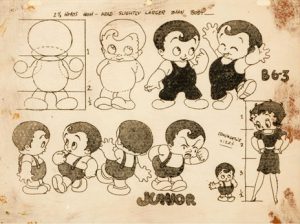 Grampy’s Indoor Outing (Fleischer/Paramount, Betty Boop, 10/16/36 – Dave Fleischer, dir. (Anim. credits unknown)) – A calliope wagon announces a carnival, in town for “Today Only – Also One Week”. Betty and Junior plan an outing to the event – but a flash of lightning appears on cue as they attempt to exit the building, followed by a downpour of rain. Junior’s eyes fill with dark clouds matching the ones in the skies above, and emit a rainstorm of their own, consisting of tears and wailing cries. The sound awakens Professor Grampy in his upstairs apartment. Determining the cause of the trouble, Grampy dons his thinking cap for a solution, and the usual light bulb goes off as he shouts, “Hooray, I’ve got it.” Inviting Betty and Junior into the apartment, Grampy first supplies carnival music, by attaching brass tacks into the surface of one roller of a laundry ringer, then placing the tines of a rake underneath them to supply the notes of a hurdy-gurdy music box. Placing a rotating clothes pole into the center of the wringer’s wash bucket, Grampy ties a basket to one spoke of the clothes pole, placing Junior inside. A spin of the pole – and Junior finds himself on an indoor airplane ride. With a flip-top wastebasket controlled by foot pedal, coupled with a weight on a pole and a washbucket at the top, Grampy constructs a high-striker for Junior to win a lollypop. A shooting gallery is constructed with a seltzer bottle at the end of a broomstick, and kitchen utensils and a cuckoo clock fot Junior to shoot at. A rotating table with an electric fan mounted underneath becomes a turntable ride. Betty and Junior are tossed off by the whirling G-forces, but land upon a wheeled folding table tethered to a light fixture above, for a short ride round and round the room. Grampy saves the best for last, pulling a lever on his porch, which not only produces from nowhere a humongous umbrella out of the roof wide enough to shield the building, but reconfigures all the railings of the fire escapes into a continuous roller coaster track around the building. Grampy joins Betty and Junior on the rolling table, and releases the tether, launching it onto the roller coaster track outside. The entire building is now depicted in a three-dimensional set, rotating around and around, to follow the path of the happy trio throughout their ride, for the fade out.
Grampy’s Indoor Outing (Fleischer/Paramount, Betty Boop, 10/16/36 – Dave Fleischer, dir. (Anim. credits unknown)) – A calliope wagon announces a carnival, in town for “Today Only – Also One Week”. Betty and Junior plan an outing to the event – but a flash of lightning appears on cue as they attempt to exit the building, followed by a downpour of rain. Junior’s eyes fill with dark clouds matching the ones in the skies above, and emit a rainstorm of their own, consisting of tears and wailing cries. The sound awakens Professor Grampy in his upstairs apartment. Determining the cause of the trouble, Grampy dons his thinking cap for a solution, and the usual light bulb goes off as he shouts, “Hooray, I’ve got it.” Inviting Betty and Junior into the apartment, Grampy first supplies carnival music, by attaching brass tacks into the surface of one roller of a laundry ringer, then placing the tines of a rake underneath them to supply the notes of a hurdy-gurdy music box. Placing a rotating clothes pole into the center of the wringer’s wash bucket, Grampy ties a basket to one spoke of the clothes pole, placing Junior inside. A spin of the pole – and Junior finds himself on an indoor airplane ride. With a flip-top wastebasket controlled by foot pedal, coupled with a weight on a pole and a washbucket at the top, Grampy constructs a high-striker for Junior to win a lollypop. A shooting gallery is constructed with a seltzer bottle at the end of a broomstick, and kitchen utensils and a cuckoo clock fot Junior to shoot at. A rotating table with an electric fan mounted underneath becomes a turntable ride. Betty and Junior are tossed off by the whirling G-forces, but land upon a wheeled folding table tethered to a light fixture above, for a short ride round and round the room. Grampy saves the best for last, pulling a lever on his porch, which not only produces from nowhere a humongous umbrella out of the roof wide enough to shield the building, but reconfigures all the railings of the fire escapes into a continuous roller coaster track around the building. Grampy joins Betty and Junior on the rolling table, and releases the tether, launching it onto the roller coaster track outside. The entire building is now depicted in a three-dimensional set, rotating around and around, to follow the path of the happy trio throughout their ride, for the fade out.
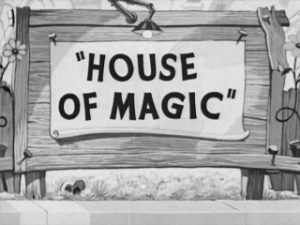 House of Magic (Lantz/Universal, Meany, Miny, and Moe, 2/8/37) – Lantz’s three Stooge-like monkeys are down and out, attempting to spend the night on a park bench under a blanket of newspapers. A rising rainstorm and thunder put a damper on their plans, as Meany’s hand reaches out from under the soggy newspapers to test the weather with his extended palm. They awaken with a start, and run for any available cover. (Effects of the rainstorm are superimposed in live-action reference footage, making for a realistic-looking effect. As did Oswald a few seasons back, they duck in a doorway, this time of a magic shop that is closed for the night. The front door has accidentally been left unlatched, with the key inside. The boys dart in, pull down the shades so as not to be observed, then lock themselves in to avoid unwanted visitors. Meany can’t figure out where to leave the key, and brainlessly takes Moe’s suggestion of a perfect hiding place – inside Moe’s gullet. The three monks begin exploring the shop for food, and a comfortable place to bed down for the night. Moe reaches for a banana from the “magic fruit” department, and gets one that sprouts a new inner core every time he takes a bite. When he breaks off the central fruit to investigate what’s inside the peel, he gets socked with a boxing glove on a spring. Meany tries to bed down on a piano bench, but has his rest disturbed by a pair of magic gloves, who play a musical game of hide-and-seek with him on the piano keyboard. More incidents with magic carpets and a magician’s hat result in Meany pursuing a white mouse from the hat into the store’s cash register, setting off a burglar alarm. Police sirens wail outside, but the monks can’t escape the front way, as the key is stuck on one of Moe’s ribs, as seen from an x-ray view inside him. With no other way out, the monks blaze their own trail, puncturing silhouette-shaped holes in the rear wall. Before leaving, Moe spots a jar of jam on a top shelf, and takes it along with him. Outside, and back in the park, the storm has stopped, and Moe shows off his prize. They unscrew the jar lid – only to be scared into a panicked run by the leap of a coiled-spring toy snake inside, for the iris out.
House of Magic (Lantz/Universal, Meany, Miny, and Moe, 2/8/37) – Lantz’s three Stooge-like monkeys are down and out, attempting to spend the night on a park bench under a blanket of newspapers. A rising rainstorm and thunder put a damper on their plans, as Meany’s hand reaches out from under the soggy newspapers to test the weather with his extended palm. They awaken with a start, and run for any available cover. (Effects of the rainstorm are superimposed in live-action reference footage, making for a realistic-looking effect. As did Oswald a few seasons back, they duck in a doorway, this time of a magic shop that is closed for the night. The front door has accidentally been left unlatched, with the key inside. The boys dart in, pull down the shades so as not to be observed, then lock themselves in to avoid unwanted visitors. Meany can’t figure out where to leave the key, and brainlessly takes Moe’s suggestion of a perfect hiding place – inside Moe’s gullet. The three monks begin exploring the shop for food, and a comfortable place to bed down for the night. Moe reaches for a banana from the “magic fruit” department, and gets one that sprouts a new inner core every time he takes a bite. When he breaks off the central fruit to investigate what’s inside the peel, he gets socked with a boxing glove on a spring. Meany tries to bed down on a piano bench, but has his rest disturbed by a pair of magic gloves, who play a musical game of hide-and-seek with him on the piano keyboard. More incidents with magic carpets and a magician’s hat result in Meany pursuing a white mouse from the hat into the store’s cash register, setting off a burglar alarm. Police sirens wail outside, but the monks can’t escape the front way, as the key is stuck on one of Moe’s ribs, as seen from an x-ray view inside him. With no other way out, the monks blaze their own trail, puncturing silhouette-shaped holes in the rear wall. Before leaving, Moe spots a jar of jam on a top shelf, and takes it along with him. Outside, and back in the park, the storm has stopped, and Moe shows off his prize. They unscrew the jar lid – only to be scared into a panicked run by the leap of a coiled-spring toy snake inside, for the iris out.
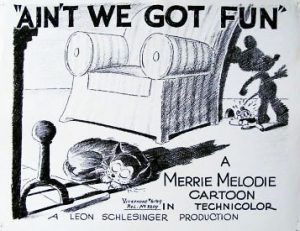 Ain’t We Got Fun? (Warner, Merrie Melodies, 5/1/37 – Fred (Tex) Avery, dir.) – A snow is falling outside, as the camera pans over to the glow of the windows of an old home. Inside, a cheery fire blazes, and a cat rests comfortably upon an easy chair. However, this is not his intended place to rest, as we discover when an old man enters the room, intent on occupying the same chair. He reacts with an outburst of anger and harsh words at finding the cat his favorite chair, and beats him off with a rolled-up newspaper. Still not content that the cat will learn a lesson, he bounces a book off the cat’s noggin as it tries to lie down upon a throw rug in the room. The cat is kept in the house for a reason – the basement is infested with mice. One of them acts as scout, and communicates to the cellar with messages written on a paper airplane when the cat’s asleep. The others zoom by the cat in one large group, disappearing into the kitchen, and make such a breeze in passing, that the cat rises to close the window, thinking the chilled air is from outside. Sight gags abound as the mice raid the pantry, complete with elevator service to various shelves of food. One mouse is posted as sentry, and instructed to whistle if the cat awakens – but foolishly bides his time by munching on a box of crackers nearby, so that when the cat does appear, the mouse can’t whistle. The cat tries to jump the mice at the dinner table, where they are feasting on a roast chicken. The mice dodge, and the cat tumbles inside the chicken carcass, continuing the chase wearing the bird. The cat runs into the wall when the first wave of mice disappear into a mousehole, and the cat sits dazed while other mice make their escape, planting foodstuffs on the cat’s person as they pass. The old man is aroused by the commotion, and, finding the cat dressed in the chicken and with his arms loaded with food, assumes the worst. He boots the cat out for eating him out of house and home.
Ain’t We Got Fun? (Warner, Merrie Melodies, 5/1/37 – Fred (Tex) Avery, dir.) – A snow is falling outside, as the camera pans over to the glow of the windows of an old home. Inside, a cheery fire blazes, and a cat rests comfortably upon an easy chair. However, this is not his intended place to rest, as we discover when an old man enters the room, intent on occupying the same chair. He reacts with an outburst of anger and harsh words at finding the cat his favorite chair, and beats him off with a rolled-up newspaper. Still not content that the cat will learn a lesson, he bounces a book off the cat’s noggin as it tries to lie down upon a throw rug in the room. The cat is kept in the house for a reason – the basement is infested with mice. One of them acts as scout, and communicates to the cellar with messages written on a paper airplane when the cat’s asleep. The others zoom by the cat in one large group, disappearing into the kitchen, and make such a breeze in passing, that the cat rises to close the window, thinking the chilled air is from outside. Sight gags abound as the mice raid the pantry, complete with elevator service to various shelves of food. One mouse is posted as sentry, and instructed to whistle if the cat awakens – but foolishly bides his time by munching on a box of crackers nearby, so that when the cat does appear, the mouse can’t whistle. The cat tries to jump the mice at the dinner table, where they are feasting on a roast chicken. The mice dodge, and the cat tumbles inside the chicken carcass, continuing the chase wearing the bird. The cat runs into the wall when the first wave of mice disappear into a mousehole, and the cat sits dazed while other mice make their escape, planting foodstuffs on the cat’s person as they pass. The old man is aroused by the commotion, and, finding the cat dressed in the chicken and with his arms loaded with food, assumes the worst. He boots the cat out for eating him out of house and home.
The cat shivers cold in the snow, while the old man sticks his tongue out at him, and the cat returns the gesture. Now, the scout mouse passes on the message that the cat’s gone. The mice take over the place, including staging a musical show to the title tune of the episode, with new lyrics and a jazzy beat. When the old man appears again, the mice, with no fear of feline intervention, bombard him with food and objects from the kitchen. The man realizes his mistake, but now is in no bargaining position to obtain forgiveness from the cat, who stubbornly remains outside while the old man pleads, “I was only fooling”. The mice observe the scene, and assume the cat is not coming back in – so take their own opportunity to jeer at the cat from the porch, and call him a scaredy cat. The cat may take it from the old man, but humiliation by mice crosses the line. He charges the door in a fury, causing the mice to scatter. All of the mice within the house are routed, and beat a retreat out the cellar door into the forest. The cat struts proudly across the room, straight over to the easy chair – and assumes the comfortable position we found him in at the opening of the cartoon. The old man comes over, and is about to repeat his action of swatting at the cat with a newspaper, but stops – thinking better of it, and realizing that he owes the cat a debt of gratitude. With sullen expression, he plods over to the throw rug, circles it a few times on all fours, and curls up upon it like the cat. He briefly raises his head to the audience, as asks, “I’m not such a mean old man, am I?” In response, the cat bounces a book off his dome, for the iris out.
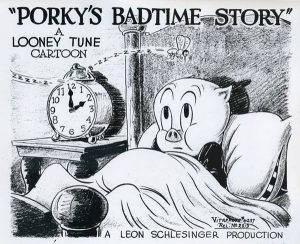 Porky’s Badtime Story (Warner, Looney Tunes (Porky Pig), 7/24/37 – Robert Clampett, dir.) – Porky and his roommate, Gabby Goat, are co-workers at the factory of Peter Piper Pickled Peppers. However, they have a recurrent habit of sleeping through the alarm of their bedroom clock, and, as has apparently happened before, arrive at work two hours late. Their effort to punch the time clock easy backfires when Gabby yanks the handle too hard, setting off an alarm bell that rouses the boss. He threatens, one more time late, and they’re fired. Porky and Gabby thus resolve to set the clock extra early and hit the sack equally ahead of schedule, to ensure no repeat performance of the morning’s disaster. The best laid plans of pigs and goats often go astray. Porky and Gabby have a miserable night, trying desperately to fall off to sleep, but having one thing after another spoil their slumber. A yowling cat has a masterful pitching arm, and keeps returning the throw of every shoe Porky can throw at it out his window – then follows up with enough shoes to supply a shoe store. Porky wages a battle against the rising moon, which keeps peeping its rays through the windows, right into Porky’s eyes – and even shifts sides of the house to dodge Porky’s pulling of the windowshade.
Porky’s Badtime Story (Warner, Looney Tunes (Porky Pig), 7/24/37 – Robert Clampett, dir.) – Porky and his roommate, Gabby Goat, are co-workers at the factory of Peter Piper Pickled Peppers. However, they have a recurrent habit of sleeping through the alarm of their bedroom clock, and, as has apparently happened before, arrive at work two hours late. Their effort to punch the time clock easy backfires when Gabby yanks the handle too hard, setting off an alarm bell that rouses the boss. He threatens, one more time late, and they’re fired. Porky and Gabby thus resolve to set the clock extra early and hit the sack equally ahead of schedule, to ensure no repeat performance of the morning’s disaster. The best laid plans of pigs and goats often go astray. Porky and Gabby have a miserable night, trying desperately to fall off to sleep, but having one thing after another spoil their slumber. A yowling cat has a masterful pitching arm, and keeps returning the throw of every shoe Porky can throw at it out his window – then follows up with enough shoes to supply a shoe store. Porky wages a battle against the rising moon, which keeps peeping its rays through the windows, right into Porky’s eyes – and even shifts sides of the house to dodge Porky’s pulling of the windowshade.
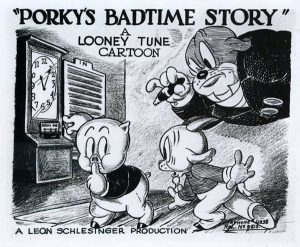 Finally, a tremendous thunderstorm breaks out outside the house. A thunderclap forces Porky to rise to shut the window, then stumble back to bed. From the ceiling, drops of water begin to fall upon the bedsheets from a leak in the roof above. Gabby is the first to awaken and notice this – but does not at first observe the source of the water. Eyeing the puddle and his bed partner Porky suspiciously, it is apparent at once what he is thinking – Porky is guilty of bed-wetting! But a drop of rain into Gabby’s eye finally makes him realize otherwise. “Why don’t somebody fix these things? How do they expect a guy to sleep, with water on the brain?” Gabby pulls out an umbrella from under the bed, and opens it above him. “Hey, don’t open an umbrella in the house. It’s bad luck”, warns Porky. “Aw, that’s a lot of baloney”, responds Gabby, adding, “You’re too super – sup – supersti – Aw, what’re you afraid of?” An answer comes to Gabby immediately, as a bolt of lightning shoots through the window, striking the umbrella, and reducing it to charred spokes. “Everything happens to me”, shouts Gabby. “I might as well try sleeping under Niagara Falls.” He gets his wish, as the hole in the roof breaks through completely, deluging Porky and Gabby in a solid river of rain water. The next morning finds the alarm clock ringing, and the bedraggled, sleep-deprived duo nevertheless racing for their clothes, and hustling with all their might to arrive at the factory door on time. Only one little flaw. A sign on the door reads “Closed Sunday”. It was their day off. So, the duo speed their car back to their bungalow, and though they only have a chest of drawers left in which to bun, fall fast asleep. The stubborn alarm clock unexpectedly attempts to ring again, but Porky awakens only long enough to smack the clock good with a mallet, then recline into blissful slumber for the iris out.
Finally, a tremendous thunderstorm breaks out outside the house. A thunderclap forces Porky to rise to shut the window, then stumble back to bed. From the ceiling, drops of water begin to fall upon the bedsheets from a leak in the roof above. Gabby is the first to awaken and notice this – but does not at first observe the source of the water. Eyeing the puddle and his bed partner Porky suspiciously, it is apparent at once what he is thinking – Porky is guilty of bed-wetting! But a drop of rain into Gabby’s eye finally makes him realize otherwise. “Why don’t somebody fix these things? How do they expect a guy to sleep, with water on the brain?” Gabby pulls out an umbrella from under the bed, and opens it above him. “Hey, don’t open an umbrella in the house. It’s bad luck”, warns Porky. “Aw, that’s a lot of baloney”, responds Gabby, adding, “You’re too super – sup – supersti – Aw, what’re you afraid of?” An answer comes to Gabby immediately, as a bolt of lightning shoots through the window, striking the umbrella, and reducing it to charred spokes. “Everything happens to me”, shouts Gabby. “I might as well try sleeping under Niagara Falls.” He gets his wish, as the hole in the roof breaks through completely, deluging Porky and Gabby in a solid river of rain water. The next morning finds the alarm clock ringing, and the bedraggled, sleep-deprived duo nevertheless racing for their clothes, and hustling with all their might to arrive at the factory door on time. Only one little flaw. A sign on the door reads “Closed Sunday”. It was their day off. So, the duo speed their car back to their bungalow, and though they only have a chest of drawers left in which to bun, fall fast asleep. The stubborn alarm clock unexpectedly attempts to ring again, but Porky awakens only long enough to smack the clock good with a mallet, then recline into blissful slumber for the iris out.
Some big rumblings at Disney, next time.


 Charles Gardner is an animation enthusiast who toils by day as a member of LA Law – but by nights and weekends indulges in classic jazz and ragtime as a performer; and studies classic Hollywood cartoons… maybe a little too much.
Charles Gardner is an animation enthusiast who toils by day as a member of LA Law – but by nights and weekends indulges in classic jazz and ragtime as a performer; and studies classic Hollywood cartoons… maybe a little too much.










































































































































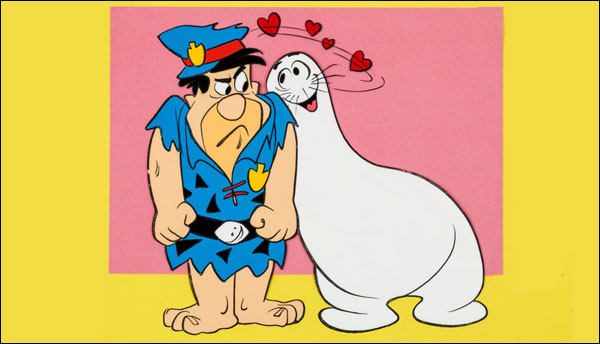























Maybe the heat wave shown in “The Hot Spell” and “Porky the Rainmaker” melted the polar ice caps enough to cause the flooding that endangered Miss Cud’s house in “Porky’s Moving Day”.
“Joe Pluvius” is derived from Jupiter Pluvius, the Roman god of rain. No wonder he’s furious at Farmer Al Falfa for — sorry, I can’t resist — stealing his thunder. Jupiter Pluvius is commonly portrayed driving a chariot through the sky pulled by a pair of eagles, rather than the weird tapir-like creatures in the cartoon. Some insurance companies offer “Pluvius cover” to provide compensation for revenue lost when an outdoor event like a carnival is canceled because of rainy weather, though this would be scant comfort to people like Betty and Junior who miss out on the fun.
I can’t believe I’m saying this, but of the three Porky Pig cartoons included here, I think the one directed by Jack King is far superior to those of Avery and Clampett. Does anyone else wish that “Dopey” had starred in his own cartoons? They could have done one called “Dopey’s Wedding Day”, where in the end he starts slugging his bride as the wedding bells ring out, until she conks him on the head with a rolling pin to show him who’s boss. “Okay, boss!” “And don’t you forget it!”
I dunno about old weather reports, but the Wheeler & Woolsey comedy “The Rainmakers” came out towards the end of 1935, if you’re looking for a common cause.
A very odd artifact is notable from the Looney Tunes lobby cards Jerry has so graciously provided to this article. Two of such cards attempt to assign numbers to the productions (Porky the Rainmaker is referred to as Looney Tune #11 on the card, and Porky’s Moving Day as #13). By the time of “Porky’s Badtime Story”, they had apparently stopped counting. But what s with these arbitrary number assignments? They do not correspond with internal production numbers, which appear on the screen inside the little enclosure on the second card of the credits sequence of each film. Counting backwards from “Rainmaker”, they do not even correspond to commence with the first film of the calendar year (excluding a few of the year’s first releases from the count). The exclusion of some early titles cannot even be explained by removing films released as Beans or Ham and Ex titles, as there are too many of these to allow for a count of Porky episodes only to add up to 11 by “Raunmaker”. The numbers do not even match up chronologically between the release order of the two titles depicted (as there were two Looney Tunes released between “Rainmaker” and “Moving Day”, which should have made “Moving Day “#14 instead of #13). Can anyone shed some light on this numerical nonsense, and on which cartoons were assigned what numbers on lobby cards of the year? It is finally ironic, as Schlesinger had produced the Buddy cartoons, that this arbitrary numbering would suggest that we were not only supposed to forget all the Bosko cartoons from the studio’s early years, but the Buddy’s as well, to believe that the :Looney Tune” was a brand new, just-beginning series in reading the lobby advertisements. Even the theme for “Tiny Toon Adventures” did more to acknowledge the studio’s past, admitting that “The teaching staff’s been getting laughs since 1933″!
Lulu the ostrich debuted in “Porky’s PET”.
Reading the passage “I was only fooling” I felt so sorry for the old man.
A classic comedic situation with Porky and Gabby Goat trying to avoid being late for work.